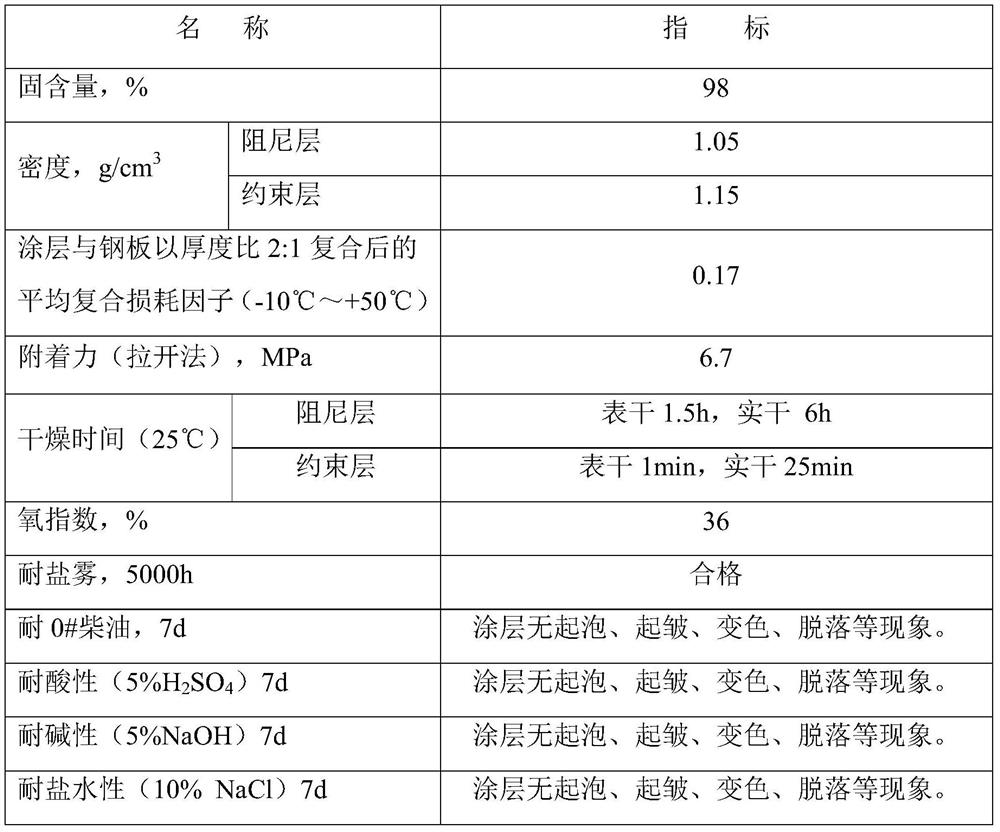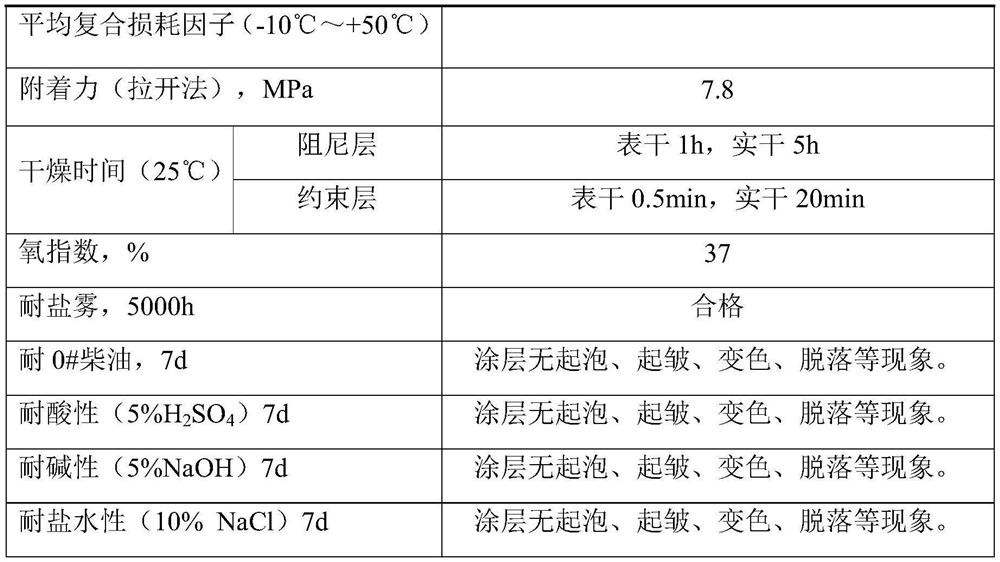A fast-curing constrained structural damping coating and its preparation method
A technology for restraining structures and damping coatings, applied in anti-corrosion coatings, fire-resistant coatings, polyurea/polyurethane coatings, etc., can solve the problems of high construction labor intensity, narrow damping temperature range, high operation period requirements, and achieve high composite loss factor. , Widening the scope of application, excellent anti-corrosion performance
- Summary
- Abstract
- Description
- Claims
- Application Information
AI Technical Summary
Problems solved by technology
Method used
Image
Examples
preparation example Construction
[0078] In addition, the present invention also provides a method for preparing the fast-curing constrained structural damping coating as described above, including:
[0079] Preparation of the damping layer: Add the glycol, dispersant, defoamer, and damping pigments and fillers into the reaction kettle, start stirring, heat up to 100-110°C while stirring, and vacuumize; when the vacuum degree reaches At -0.1MPa, dehydrate for 1.5-2 hours, then lower the temperature to 50-60°C, add the diisocyanate dropwise, and then raise the temperature to 80-90°C after the dropwise addition, keep the temperature for 2-4 hours, and wait until the NCO content reach 4.0-8.0 wt%, lower the temperature to 50-60°C, add the adhesion promoter, substrate wetting agent, catalyst, latent chain extender and stir evenly to obtain the damping layer;
[0080] The preparation of the A component: Put the polyol and liquid flame retardant into the reaction kettle protected by nitrogen, heat to 100-110°C under...
Embodiment 1
[0086] 1. Preparation of damping layer
[0087] Add 200 parts of polyether DL1000, 5 parts of dispersant BYK110, 1 part of defoamer BYK141, 2 parts of defoamer BYK066N, 500 parts of 200-mesh mica powder into the reaction kettle, start stirring, and heat up to 100°C while stirring. Vacuum. When the vacuum degree reaches -0.1MPa, after dehydration for 2 hours, lower the temperature to 50-60°C, continue to add 65 parts of IPDI, after the dropwise addition, raise the temperature to 80-90°C, keep the temperature for 4 hours, and wait until the -NCO content reaches After the target value is 7.0%, lower the temperature to 40-50°C, add 1.0 parts of vinyltrimethoxysilane of adhesion promoter, 0.5 parts of substrate wetting agent Wet260, 1.0 parts of first catalyst dibutyltin dilaurate, 152.2 After mixing one part of latent chain extender Hardener OZ evenly, it can be filtered and packaged for discharge.
[0088] 2. Preparation of Constraint Layer
[0089] (1) Preparation of componen...
Embodiment 2
[0097] 1. Preparation of damping layer
[0098] Add 150 parts of polytetrahydrofuran glycol PTMEG650, 10 parts of dispersant Dispers912, 2 parts of defoamer Tego940, 3 parts of defoamer BYK141, 300 parts of 200-mesh mica powder, 200 parts of 80-mesh graphite powder into the reactor, and start stirring , heated up to 100°C while stirring, and vacuumed. When the vacuum reaches -0.1MPa, after dehydration for 2 hours, lower the temperature to 50-60°C, continue to add 100 parts of HMDI, after the dropwise addition, raise the temperature to 80-90°C, keep the temperature for 2-4 hours, and wait for -NCO After the content reaches the target value of 5.0%, lower the temperature to 40-50°C, add 2.0 parts of γ-glycidyl etheroxypropyl trimethoxysilane of adhesion promoter, 1.0 parts of substrate wetting agent BYK333, 2.0 parts of first After the catalyst tetrabutyl titanate and 83.9 parts of latent chain extender VestaminA139 are stirred evenly, they can be filtered, packaged and dischar...
PUM
| Property | Measurement | Unit |
|---|---|---|
| particle size (mesh) | aaaaa | aaaaa |
| thickness | aaaaa | aaaaa |
Abstract
Description
Claims
Application Information
 Login to View More
Login to View More - R&D
- Intellectual Property
- Life Sciences
- Materials
- Tech Scout
- Unparalleled Data Quality
- Higher Quality Content
- 60% Fewer Hallucinations
Browse by: Latest US Patents, China's latest patents, Technical Efficacy Thesaurus, Application Domain, Technology Topic, Popular Technical Reports.
© 2025 PatSnap. All rights reserved.Legal|Privacy policy|Modern Slavery Act Transparency Statement|Sitemap|About US| Contact US: help@patsnap.com



